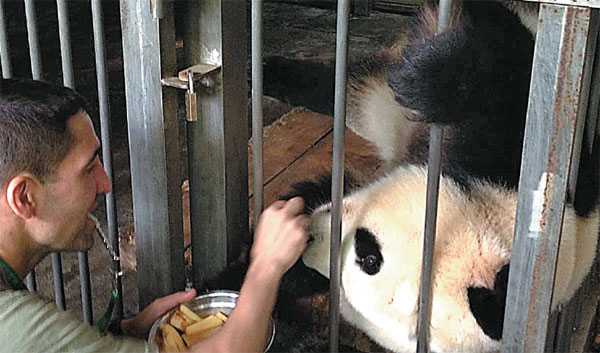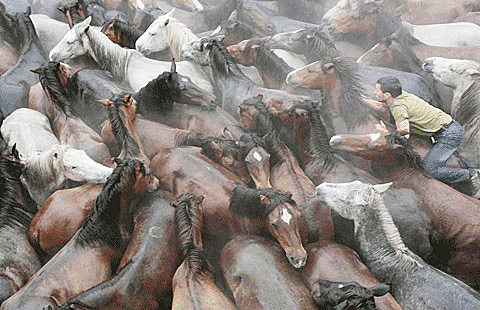Playing with pandas
Updated: 2014-02-25 07:30
By Huang Zhiling (China Daily)
|
|||||||||||
My China Dream | James Ayala
|
James Ayala feeds female giant panda Jing Jing a slice of apple at the Chengdu Research Base of Giant Panda Breeding. Photos by Huang Zhiling / China Daily |
He started his career training the sea animals on New York's Coney Island, and now he has his dream job working with giant pandas in Chengdu. But James Ayala's work is more than just fun and games - it's a critical part of the research of these endangered animals. Huang Zhiling reports in Chengdu.
'Honey, come here," he whispers.
James Ayala's tone suggest she is speaking to his girlfriend, but his words are directed to Jing Jing, a 9-year-old female giant panda.
"I have spent a lot of time with Jing Jing. It is important to make the animal you work with feel comfortable. Jing Jing doesn't know what I say but understands my tone. If I am nervous, she will feel my tension and get nervous too," says Ayala, a 39-year-old researcher of animal behavior from the United States.
Ayala is the only full-time foreign employee of the Chengdu Research Base of Giant Panda Breeding in the northern suburbs of Chengdu, Sichuan province. He has been working at the base since May 2012, serving as a consultant in the daily care of the 70-odd giant pandas that live there.
He has managed to train Jing Jing to take an ultrasound examination without being anesthetized, which is important because excessive use of anesthetic drugs can harm the animals.
"Jing Jing is in her breeding stage. The ultrasound is important to deter-mine whether she is pregnant," says Ayala, who has taught Jing Jing to lie down and roll over so that vets can examine her.
Born and raised in New York, Ayala, who received his master's degree in conservation biology at Antioch University in New Hampshire, started training animals at the Coney Island Aquarium in Brooklyn, working with seals and walruses, when he was only 22.
Since then, he has trained beluga whales, sealions, several different species of monkey and Asiatic black bears.
The first time Ayala saw agiant panda was around 1980 when he was 5." I was obsessed with animals so my parents took me to the National Zoo in Washington DC to see Ling Ling and Hsing Hsing, the two pandas from China. This was the only place in the US at the time that had pandas. I remember waiting forever in line to see them and then being disappointed because they were so faraway," he says.
In February 1972, after US President Richard Nixon's visit to China, the Chinese government presented the two pandas to the US as gifts, and the animals were instantly popular with the public.
"Pandas are arguably the most famous and controversial of the endangered species. Working on a conservation project of this magnitude has been a dream of mine since I first started working with wildlife 17 years ago," Ayala says.
"I am working to improve the way we train and manage pandas in captivity so that we can help save this iconic and endangered species."
Ayala was excited the first time he saw the pandas up close at the base, but when he thought about how he was going to train the pandas, he became worried.
"Pandas can be 150 kilograms. The first time I fed a panda, I was very nervous because its mouth was so big and its jaws are so powerful. It could take your hand right off," he says.
The first panda Ayala trained for an ultrasound was Jing Jing. She is very famous because she was chosen as the living mascot for the 2008 Beijing Olympics. She symbolized the black Olympic ring and was one of the five Fuwa mascots who represented different endangered species of China.
Based on his past experience in animal training, he knew the first step was to gain her trust and establish a working routine with her.
"All animals respond differently to training and interaction with people. However, the principles of positive reinforcement, which we use to train animals, are the same. You always want to reward 'good' behaviors and encourage the animal to feel positive about the work you are doing," Ayala says.
He decided to begin by observing panda habits.
"Pandas eat mostly bamboo. But they really love sweet things such as honey and apples. So we use this as a treat for training," Ayala says.
Jing Jing is in her breeding stage when she has a chance to conceive. Because of this, it is essential to monitor her for pregnancy. A panda can behave as if she is pregnant and the hormones from her urine and feces can indicate she is pregnant. However pandas have the ability to fake pregnancy and not give birth. An ultra-sound is the only way to tell for certain whether a panda is pregnant, so it is important to train her to undergo the examination voluntarily. Before a veterinarian can perform an ultrasound on Jing Jing, Ayala had to teach her to lie down and rollover.
To position the panda, he trained her to touch her nose to the tip of a pole. Together to lie down, he put the tip very low on the ground so she had to lie on the floor.
When Jing Jing acted as he wanted her to, Ayala would reward her with a slice of apple and a scratch on the back.
After working with Jing Jing for six months, Ayala found her restless one day and thought she might be pregnant. He managed to make her lie down and roll over before an examination.
"However, a baby could not be seen. Jing Jing has never been pregnant. This is the perfect example of the pseudo or 'false' panda pregnancy," Ayala says.
After Jing Jing, Ayala used the same method to train three other pandas to have the ultrasound examination.
Other panda experts in the base say Ayala's job is very important and essential to their work in preparing the animals to be released into the wild.
"By training captive pandas to give blood and submit to exams, we can better understand their health and reproductive cycle, thus improving our captive breeding methods. Training pandas also reduces stress and improves the welfare of our captive population so that they can have healthy offspring for the release program," the base chief Zhang Zhi he says.
Ayala also helps to train red pandas on the base. To shift all 103 of them from one den to another, keepers used to capture them using nets which can be quite difficult. It was Ayala who came up with the idea of teaching them to enter a crate so they can be moved more easily.
"It took me many months to train the red pandas. They are very shy and timid. First I had to teach them to eat from my hand and then, like the giant panda, I taught them to touch their noses to a pole. Once they learn to touch their noses to the pole, all you have to do is put the tip in the crate and they will enter it," he says.
While he finds red pandas very cute, they can scratch and bite very hard, much harder than a cat or dog of the same size. This is because, like giant pandas, they have strong jaws for breaking bamboo, says Ayala, showing the scratches on one of his hands.
Ayala has a tremendous amount of respect and admiration for his colleagues and hopes to continue his work at the panda base for as long as possible.
"I feel like part of a big family here, I work so intimately with my co-workers like Liu Songrui and Lou Li. They are just like my sisters and never let me get homesick," Ayala says.
Ayala admits that he has fallen in love with the laid-back Chengdu life-style, known for it's picturesque tea-houses, hotpot and spicy food.
He likes the spicy tofu in a famous local restaurant near his house." Each week, I visit the Chen Mapo Tofu Restaurant at least once," he says.
"James enjoys his life no matter at work or after work. When he is working, he is 100 percent focused on the work it self," says Lou Li, a veterinarian in the base.
"After work, he is a pure Chengdu native. I can't say he is a foreigner because he enjoys the Chengdu lifestyle a lot."
Contact the writer at huangzhiling@chinadaily.com.cn.
Hot Topics
Wei Guirong drives his granddaughters from kindergarten on his home-made three-wheeled vehicle in Luorong county, Liuzhou city of Guangxi Zhuang autonomous region, on May 19.
Editor's Picks

|

|

|

|

|

|








